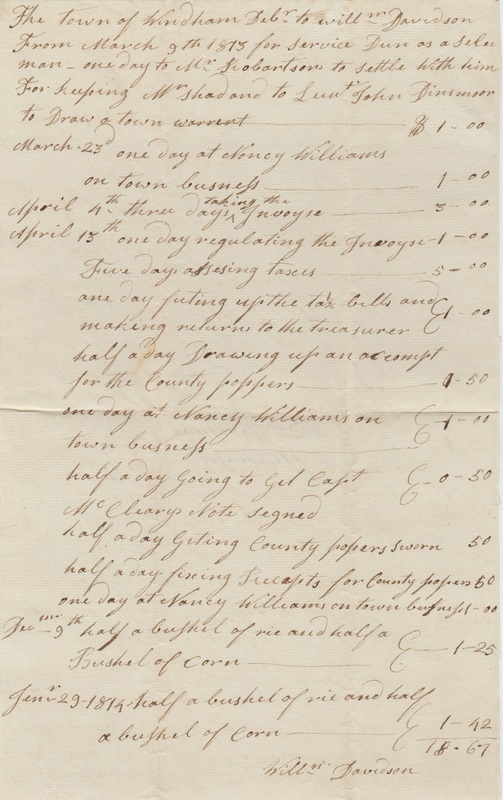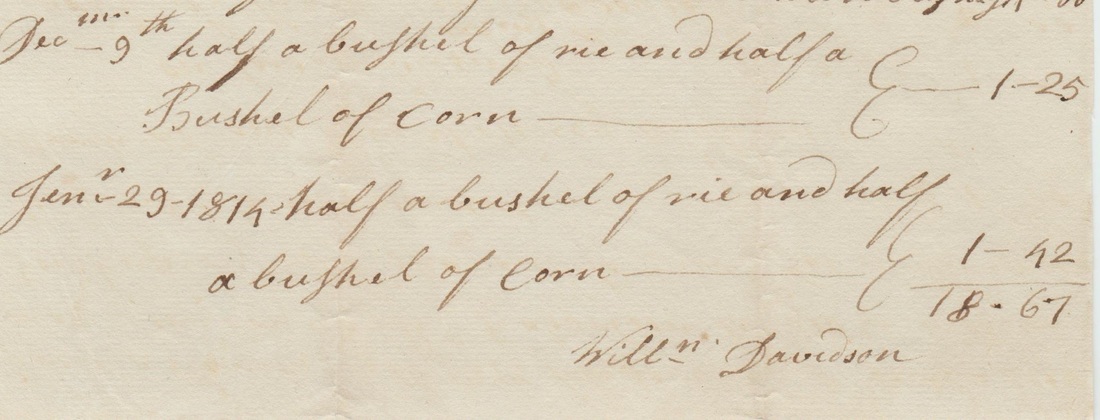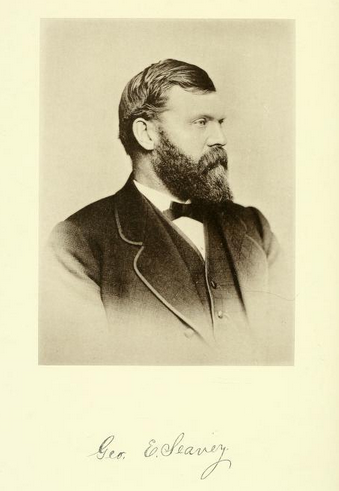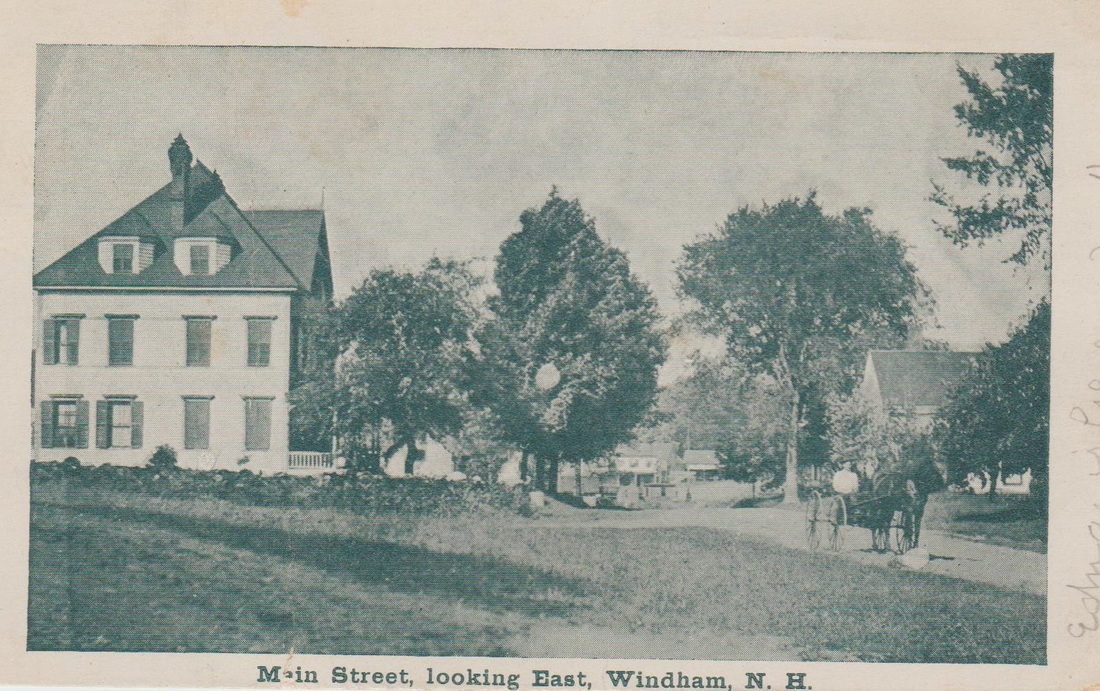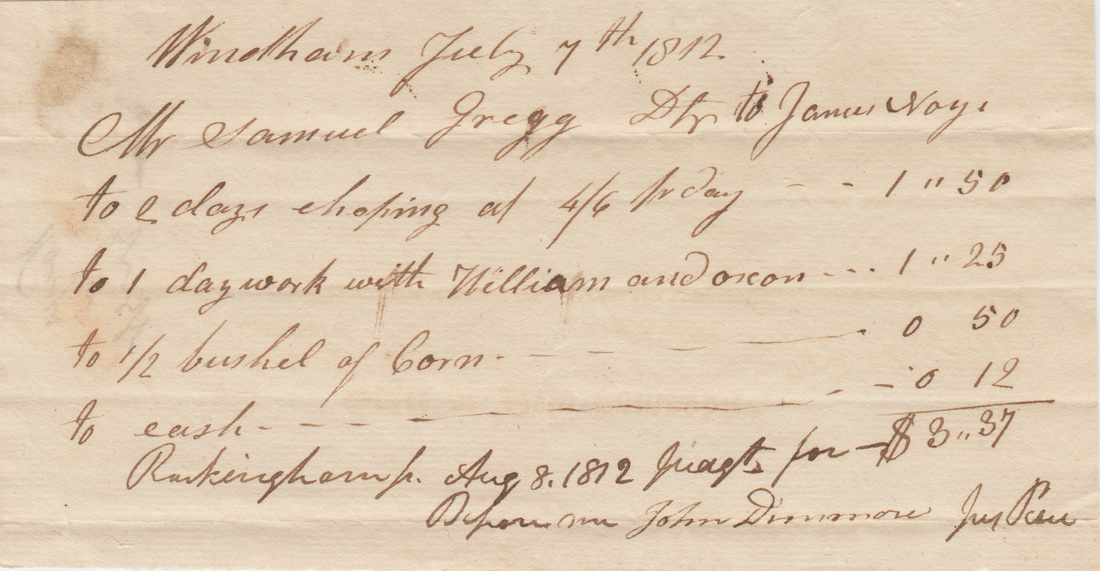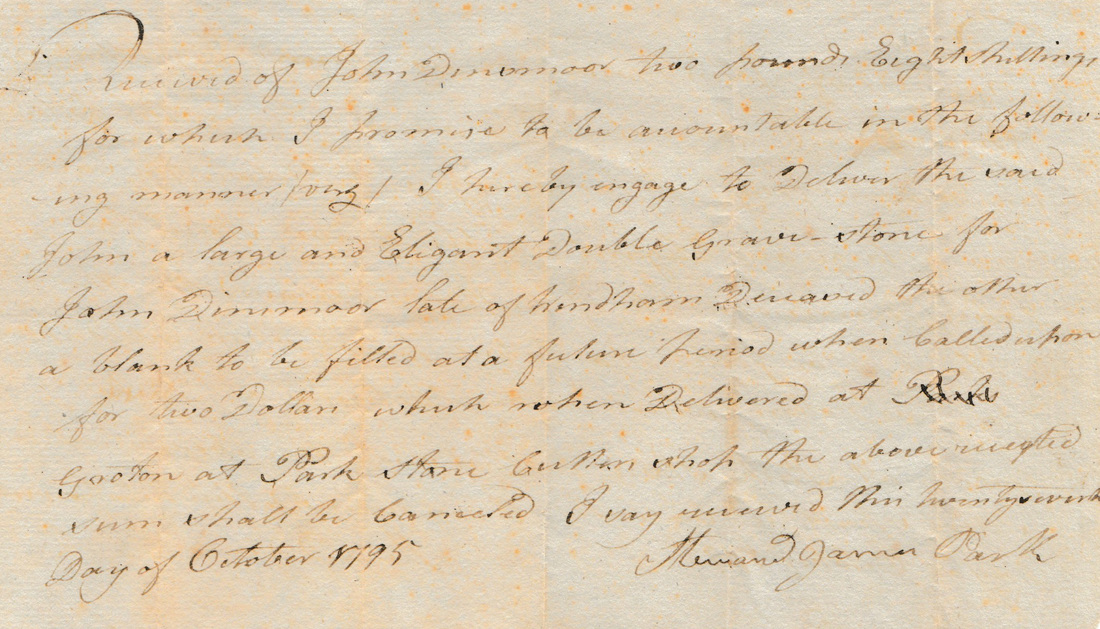|
Deacon William Davidson was born in Windham on October 15, 1761 to John Davidson and his wife, Sarah McNutt. John was a town selectman in 1760 and 1761. Following in his father's footsteps, William served as town selectman for several years: 1806, 1810, 1811, 1813, 1816, and 1817. He was also deacon in the church for several years up until 1826. He is noted as having been popular in town and as being, "pleasant and affable; kind and courteous in his bearing towards others". On December 14, 1790 he married Jane Barnet of Londonderry, who was born on June 24, 1765. The couple had eight children together between 1791 and 1808. The following is an account of some of William's general duties as town selectman in 1813. He recorded, and was paid for, each individual task. On March 9, 1813 William was paid $1.00 for drawing up a town warrant with Lieutenant John Dinsmoor. On March 23 William spent one day attending to town business at the house of Nancy Williams. In 1810 she received an innkeeper license from the town. The following expense for April 4th is for "taking the invoyces", First, $1.00 for one day of regulating invoices. He was then paid $1.00 for five days for assessing taxes. He was again paid $1.00 for a day's worth of work, which consisted of "puting up the tax bills" and then returning to the town treasurer. One of the more interesting duties of the selectman was "drawing up an account for the County poppers [paupers]. Following that there is another day of conducting town business at the home of Nancy Williams for which he was paid $1.00. Next is an expense of $0.50 "to get Capt McCleary Note Signed". Captain John McCleary served in the Revolutionary War and helped capture thirteen merchant ships as a privateersman. He marched to Saratoga against the army of General Burgoyne. William Davidson then spent half a day getting the county papers sworn. As well as another duty related to the county papers. Both of which he was paid for $0.50; selectman seemed to have been payed about a $1.00 for work with few exceptions. Again, he later conducted more town business with Nancy Williams. In late 1813 and early 1814 there is a change in William's duties and he is recorded as having billed the town for half a bushel of rye and half a bushel of corn.
0 Comments
The following is an excerpt from a short biography of George Seavey published in 1915: GEORGE E. SEAVEY, formerly a prominent lumber dealer and sawmill operator, and one of the leading citizens of the town of Windham, Rockingham County, N. H., was born in Pelham, Hillsborough County, N. H., June 20, 1839. His parents were Benjamin and Sarah (Coburn) Seavey. He was a grandson of Joseph Seavey, who in his day was a prominent citizen of Pelham. Benjamin Seavey, father of the subject of this sketch, was born in Pelham, and early in life learned the wheelwright's, trade, which he followed for a number of years. Later he engaged in the manufacture of lumber, and, removing from Pelham to Windham, carried on that business here until his death in 1886. George E. Seavey was twelve years of age when he accompanied his parents to Windham. After leaving school he became associated with his father in the lumber business, and continued with him until attaining his majority, at which time he engaged in the business for himself in the eastern part of the county. Later he established himself at Windham Depot, where he carried on a flourishing lumber business until his death, which occurred August 18, 1910. For thirty years he was a prominent factor in the lumbering manufacturing industry of this section. An active and public spirited citizen, he took a prominent part in local politics, serving four years as select- man, for a number of years as supervisor, and representing the town in the legislature in 1883-84 and again in 1893. He was a member of St. Marks Lodge, A. F. & A. M., of Derry, and was prominent socially, having a large acquaintance throughout the county, to whom his death was a source of great sorrow. Mr. Seavey was married, November 10, 1868, to Miss Mary Ballou, a daughter of Edward and Isabella (McGregor) Ballou, of Derry, N. H. Mrs. Seavey's ancestry can be traced back through successive generations of the McGregors to the first settlers in Rockingham County. Mrs. Seavey survives her husband and resides in Windham, where she is widely known and highly esteemed.
Although the minutiae of history may often be overshadowed by larger events, it is interesting, and important, to explore the daily lives of those who lived through it. The history of Windham is not an exception. Samuel Gregg was born in Windham, NH on November 8, 1786 to Deacon William Gregg and his wife Isabel. In 1812 he married Jennie Dickey of Londonderry, NH. Gregg was a blacksmith and his business was located in Windham Centre, where he also resided. He died at 43 years of age in 1829 and his wife passed away nearly 50 years later at 88 years of age. The July 7, 1812 receipt below is for monies to be paid to Samuel Gregg by James Noyes. The receipt includes: - 2 days of chopping at 4/6 per day . . . 1.50 - 1 day work with William Anderson . . . 1.25 - 1/2 bushel of Corn . . . . . . . . . . . . . . . . 0.50 - cash . . . . . . . . . . . . . . . . . . . . . . . . . . . . . 0.12 $3.37 James Noyes was born in 1786 to Moses Noyes and his second wife, Phebe Richardson. Noyes lived on the family farm in the south part of town with over 100 acres. He lived most of his life caring for his parents and relieving the household of its debt. On March 14, 1816 he married Abigail R Lovejoy of Amherst. She is noted as having been, "a woman of cultivated tastes and sterling piety". Together the couple had eight children. James is recorded as having said, "I have worn these stones smaller, digging around them to raise corn and potatoes", referring to the rocky soil found on many early Windham farms. It is noted in records that Noyes spent the majority of his life in good health, requiring the care of a doctor only once. However, in old age his mental capacities began to weaken. James Noyes died on December 26, 1870, just over six years after his wife died.
John Dinsmoor was born in Ireland in 1721 to Robert and Margaret Orr Dinsmoor, and came to Windham with his parents and three siblings in 1730. John later married Martha McKeen of Londonderry and the their family grew to include thirteen children. Dinsmoor is recorded as having been one of the leading men of the town, serving as town clerk, a moderator at town meetings, selectman, justice of the peace, elder at the Presbyterian church, and a delegate to the Provincial Congress at Exeter in 1775. He died in Windham in 1793. However, as evidenced by the late 1795 bill above, it was approximately two years before a, "large and Elegant Double Grave - stone" was purchased for his grave by his son, John. The bill for two pounds eight shillings also included a provision for the second, "two Dollar" blank gravestone to be filled at a later date, possibly when John's wife, Martha passed away.
John Dinsmore was born in Windham on June 26, 1759. He later married Susannah Bell of Londonderry and settled on the John-Kelley farm. In 1800, the family relocated to the lower village of Derry where he kept a hotel. Dinsmore is recorded as having been, "a man of great personal worth, and highly esteemed by his townsmen". His wife died on October 27, 1807 and he remarried shortly after to Mary Rogers. Tragically, John, his wife, and three of his daughters died of consumption, or tuberculosis, in Derry. Before his death in 1814, Dinsmore believed that it was the climate of New England that was so conducive to contracting tuberculosis that he urged his remaining family to move to a more moderate climate, which they did following his death. It is unclear if Dinsmore ordered the case clock for his residence or the hotel. However, he was certainly prosperous enough to purchase a clock, which was a luxury item at the time. He paid $65 for to Timothy Chandler to build him a mahogany case clock. Chandler was born in 1752 in Concord, New Hampshire. He relocated to Connecticut in the 1780s to serve as an apprentice to a wool carder. It is believed that it is during this time that he learned the clock making trade. In 1791 he returned to Concord and set up shop as a silversmith and clock maker. Several years later, in 1797, Chandler signed up with the local militia and rose to the rank of Major by 1799. In 1809, shortly after he had built Dinsmore's clock, Chandler's shop furnace caught fire and burned his shop and home to the ground. The fire resulted in a $5,000 loss, a significant amount at a time before the widespread use of insurance. The people of Concord were generous enough to raise $1,200 for Chandler, which helped him rebuild and continue as a clock maker. Timothy Chandler later died on August 9, 1848.
|
AuthorDerek Saffie is an avid Windham historian who enjoys researching and sharing his collection with all those interested in the history of the New England town. Archives
November 2019
Categories
All
|
